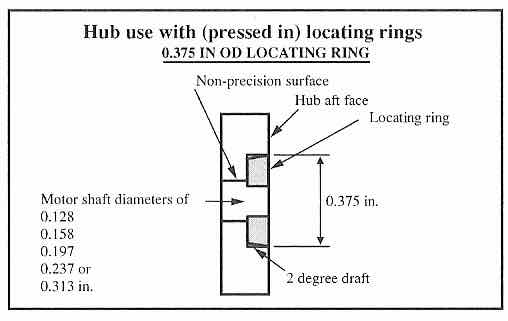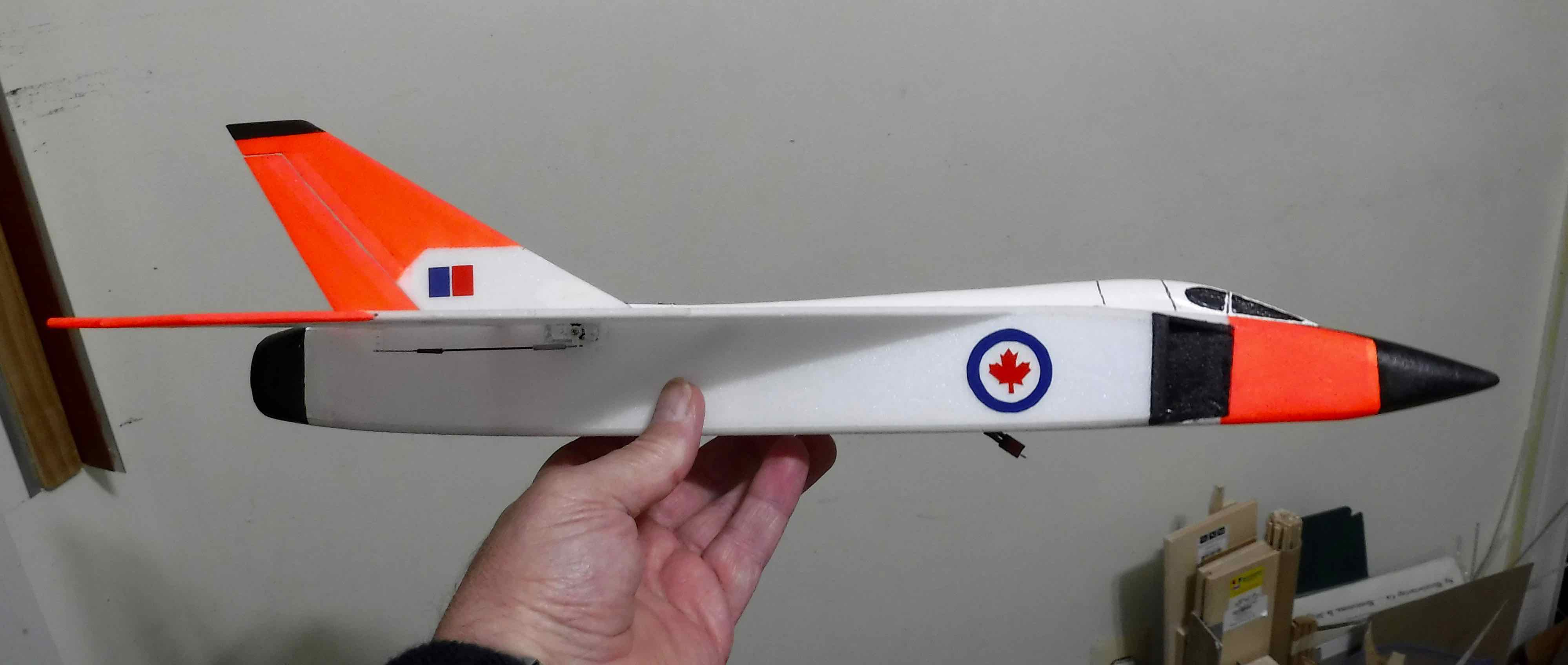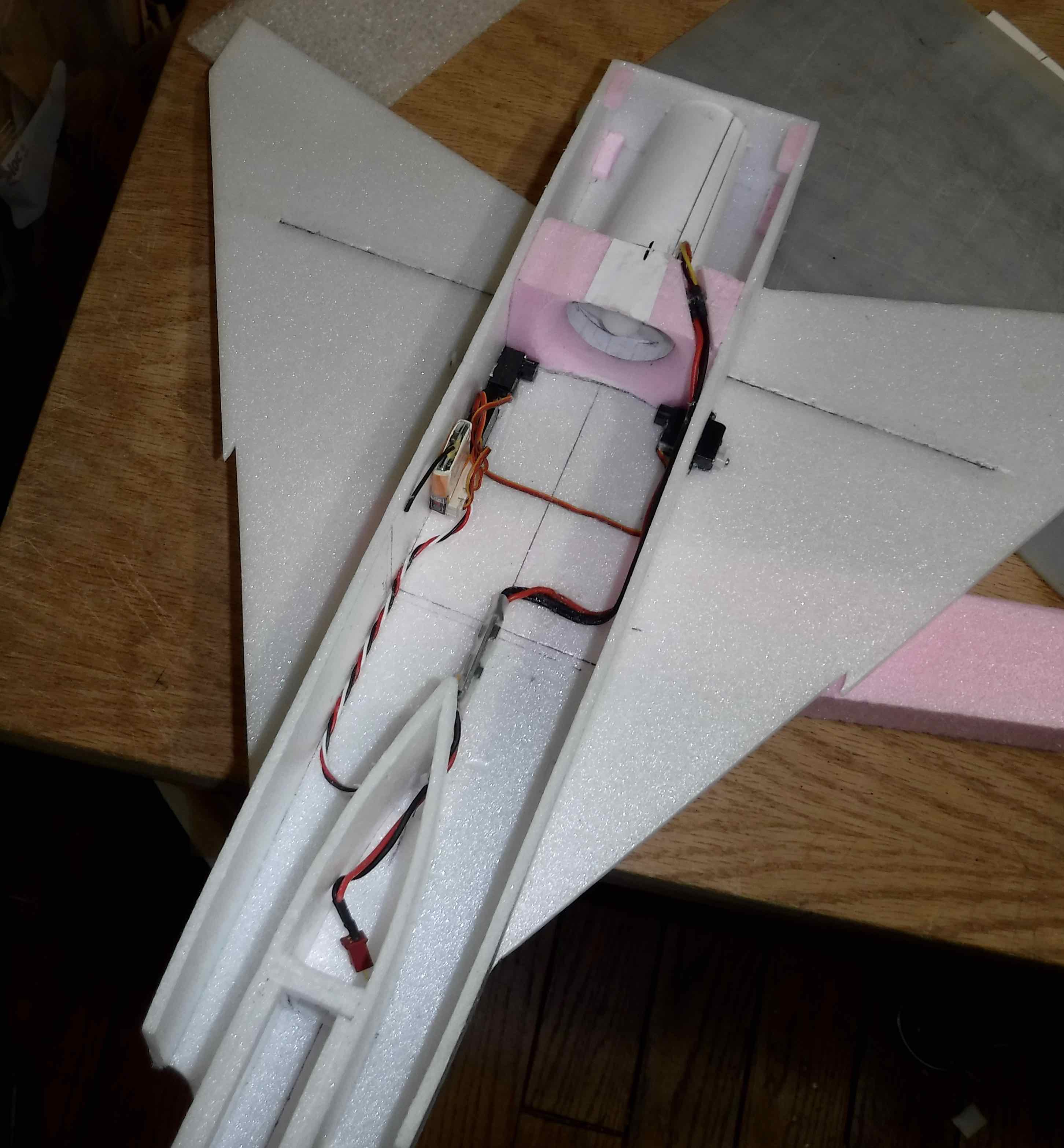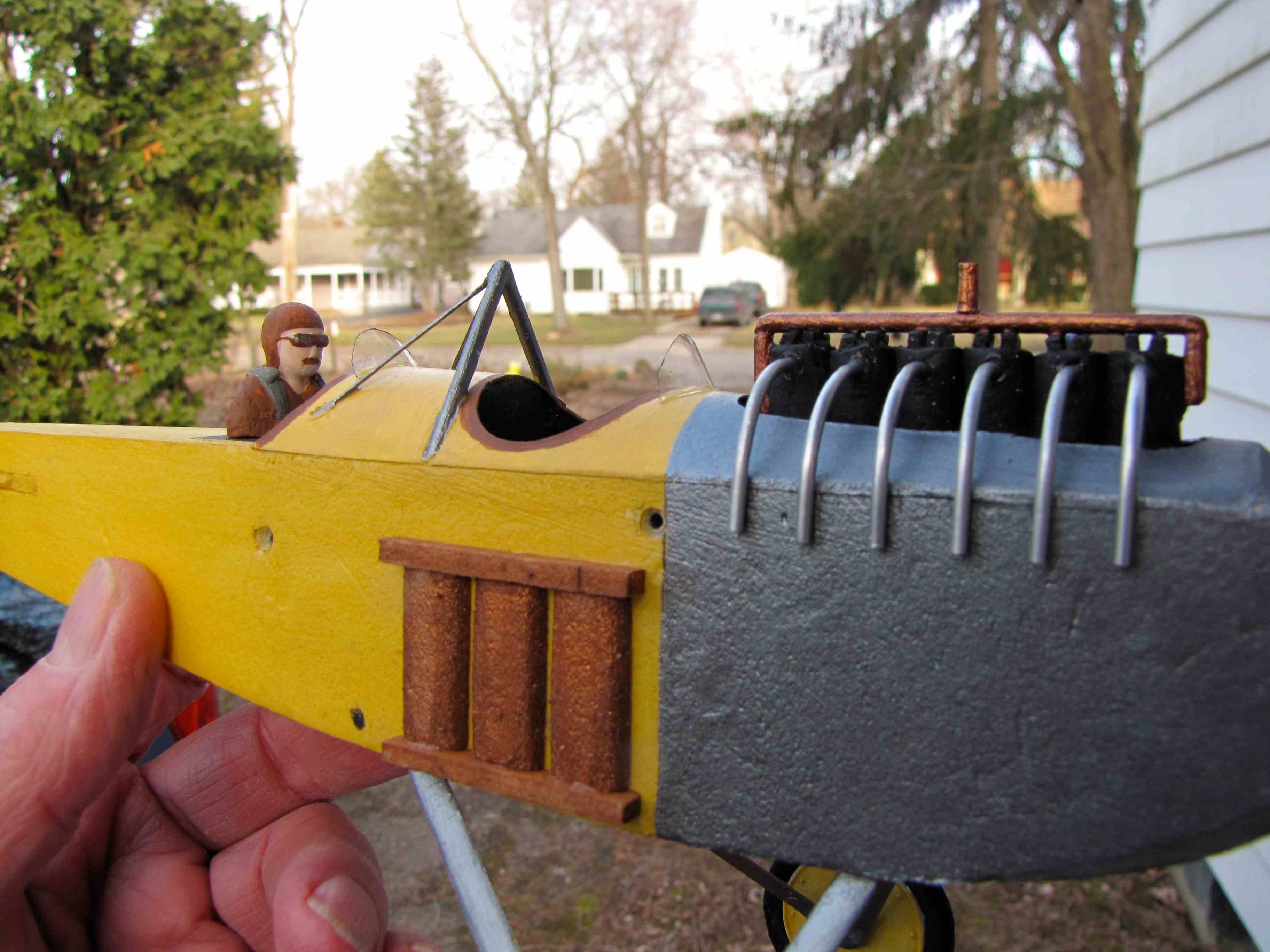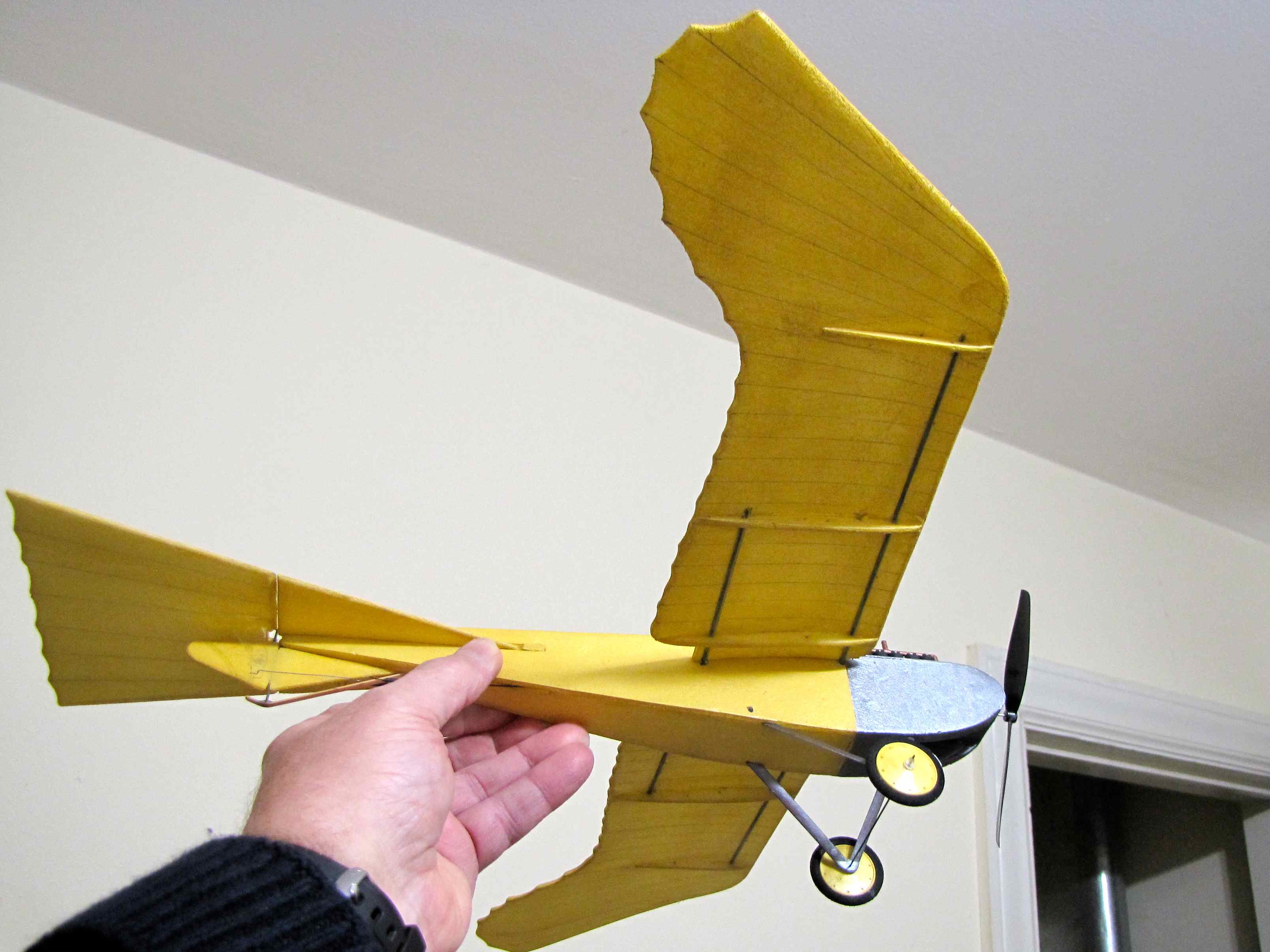 |
Flying High With Electric Power!
The Ampeer ON-LINE!
Fly the Future - Fly Electric! |
|---|
Site Table of Contents
| President: | Vice-President: | Secretary-Treasurer: |
| Ken Myers | Richard Utkan | Rick Sawicki |
| 1911 Bradshaw Ct. | 240 Cabinet | 5089 Ledgewood Ct. W. |
| Commerce Twp., MI 48390 | Milford, MI 48381 | Commerce Twp., MI 48382 |
| (248) 669-8124 | (248) 685-1705 | (2480 685-7056 |
 | ||
| Board of Directors: | Board of Directors: | Ampeer Editor |
| David Stacer | Arthur Deane | Ken Myers |
| 16575 Brooklane Blvd. | 21690 Bedford Dr. | 1911 Bradshaw Ct. |
| Northville, MI 48168 | Northville, MI 48167 | Commerce Twp., MI 48390 |
| (248) 924-2324 | (248) 348-2058 | (248) 669-8124 |
| The Next Flying Meeting: Date: Saturday, June 8 Time: 10:00 a.m.
PLEASE NOTE: THE DATE IS TENTATIVE AND DEPENDS ON THE MIDWEST FLYING FIELD CONDITION AND WEATHER Place: Midwest RC Society 7 Mile Rd. Flying Field | ||
| Upcoming Watts Over Wetzel Electric Fly-in Upcoming meet info. | Balancing APC Props and Using the APC Prop Insert CORRECTLY Ken shares the APC info than many folks may have missed year after year! |
| Upcoming Skymasters' Electrics' Over Lake Orion Upcoming meet info | Peanut Scale Avro Arrow - From Trash to Treasure Keith Shaw describes his latest 'fun' build |
| A Different Way of Calculating Wing Area and Various Wing Loading Methods Compared Ken describes a different way to calculate wing area, and how to use it. | Upcoming 35th Annual Mid-America Electric Flies 2019 Info on this upcoming annual event. |
From rccdlocalclubs@emaildodo.com Dear AMA Club Leader, The Radio Control Club of Detroit (RCCD) is inviting any of your club's membership who enjoy all electric flying to come and participate in our 14th WOW - Watts Over Wetzel Event. WOW is in total operation over the two-day period of Saturday and Sunday, June 1 and 2, 2019. We want your club members to know that they are most welcome to come and participate in this major fly-in and to renew old AMA friendships and create new ones. Jim Lundberg
Date: Sat-Sun - June 1 & 2, 2019 Pilots Meeting: 8:45 am, Flying From: 9am-5pm AMA Sanction: 8405 Location: RCCD Field: Wetzel State Recreation Area, (MI State Park Recreation pass required) Event Type: Electrics only - Fun Fly, No size restriction - small or large, Helicopters & Quads welcome, 110V AC On-site, Concessions Available, Raffles, Limited bleacher seating, Sun Shades Suggested, Vendors on site CD’s:
Participant Requirements:
COME JOIN US! IF YOU ARE INTO ELECTRIC FLYING, THIS IS THE PLACE TO BE! RCCD's Annual Electric Fly-In has grown leaps and bounds over the years boasting a large number of pilots. Ample parking means all your friends and fellow electric pilots will be here, and so should you! Contest Directors, Kevin Glynn, Dan Galasso, and the rest of the RCCD family invite you to our awesome flying site for a weekend filled with fun, friends, great concessions, 50/50 raffles, vendors, electric flying, prizes and more! Stay up to date at www.rccd.org or on our Facebook page at https://www.facebook.com/TRCCD/ Balancing APC Props and Using the APC Prop Insert CORRECTLY Many APC props come with inserts for sizing to the shaft diameter. There is always the following insert, but how many of us actually take the time to read it? It is especially important to know when balancing your APC prop! Please take a few moments to read and look carefully at it NOW! 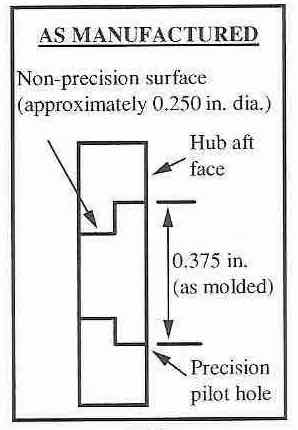 The hubs may be precisely adapted to motor shaft diameters of 0.128, 0.158, 0.197, 0.237, and 0.313 inches. Remove the desired locating ring by twisting. Insert the ring with the draft angle as shown in the lower figures. The hubs may be adapted to other shaft diameters by drilling the non-precision 1/4 in. Hole with a desired diameter through drill. 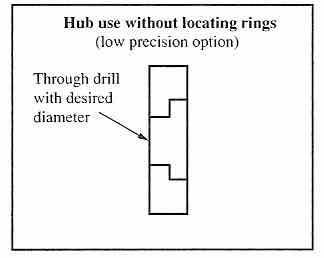
Upcoming Skymasters' Electrics' Over Lake Orion Night Fly - Saturday, June 8, 8 p.m. to 12 a.m.
Bonfire and Night Flying on Saturday evening!
Lots of Parking
Flying field is located within the Bald Mountain Recreation Area, about 5 miles north of the Palace of Auburn Hills on Scripps Road. Take M-24 exit from I-75 and come 1 mile west off M-24 on Scripps. All vehicles require a Recreation Passport available from Secretary of State or DNR. 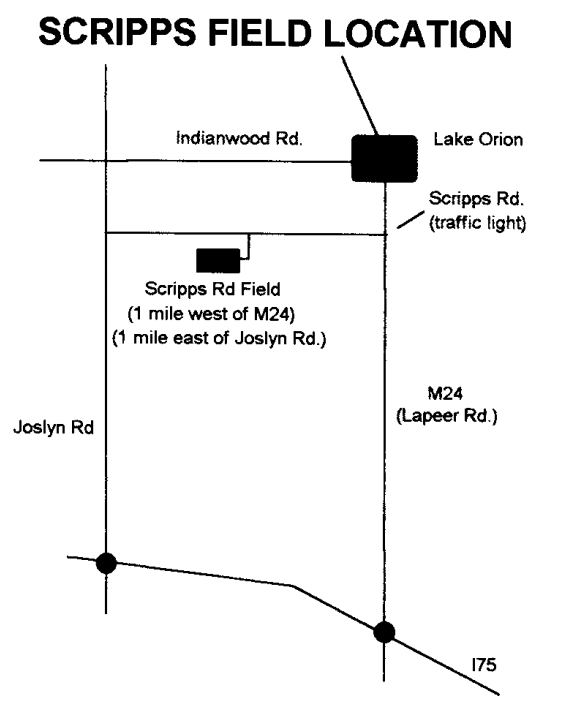 For more information email electricfly@skymasters.org
Return to "What's In This Issue" Peanut Scale Avro Arrow
I needed to take a break from a major project I am working on, so decided to make a Peanut Scale (13") Canadian Avro Arrow. I always liked the Arrow and was crushed by its untimely cancelation and destruction at the hands of a disastrous Prime Minister who hated any technology more advanced than a farm tractor. 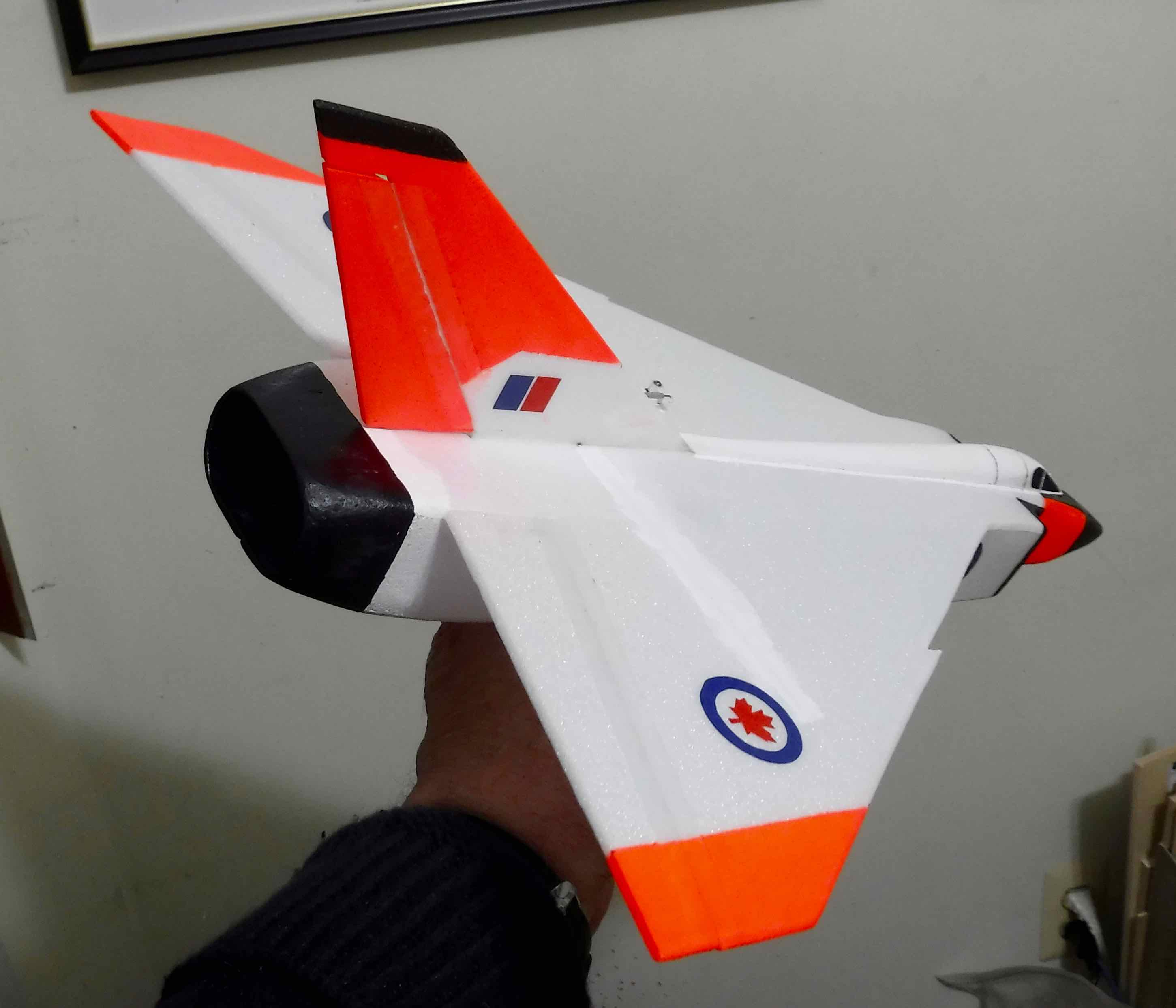 What initiated the project was the remains of a Great Planes' Sabre Jet that I retrieved from a trash can at our winter indoor flying site. The owner's bad hand launch reduced it to shredded rubble due to the very brittle foam used in its construction. I kept it to become an organ donor. 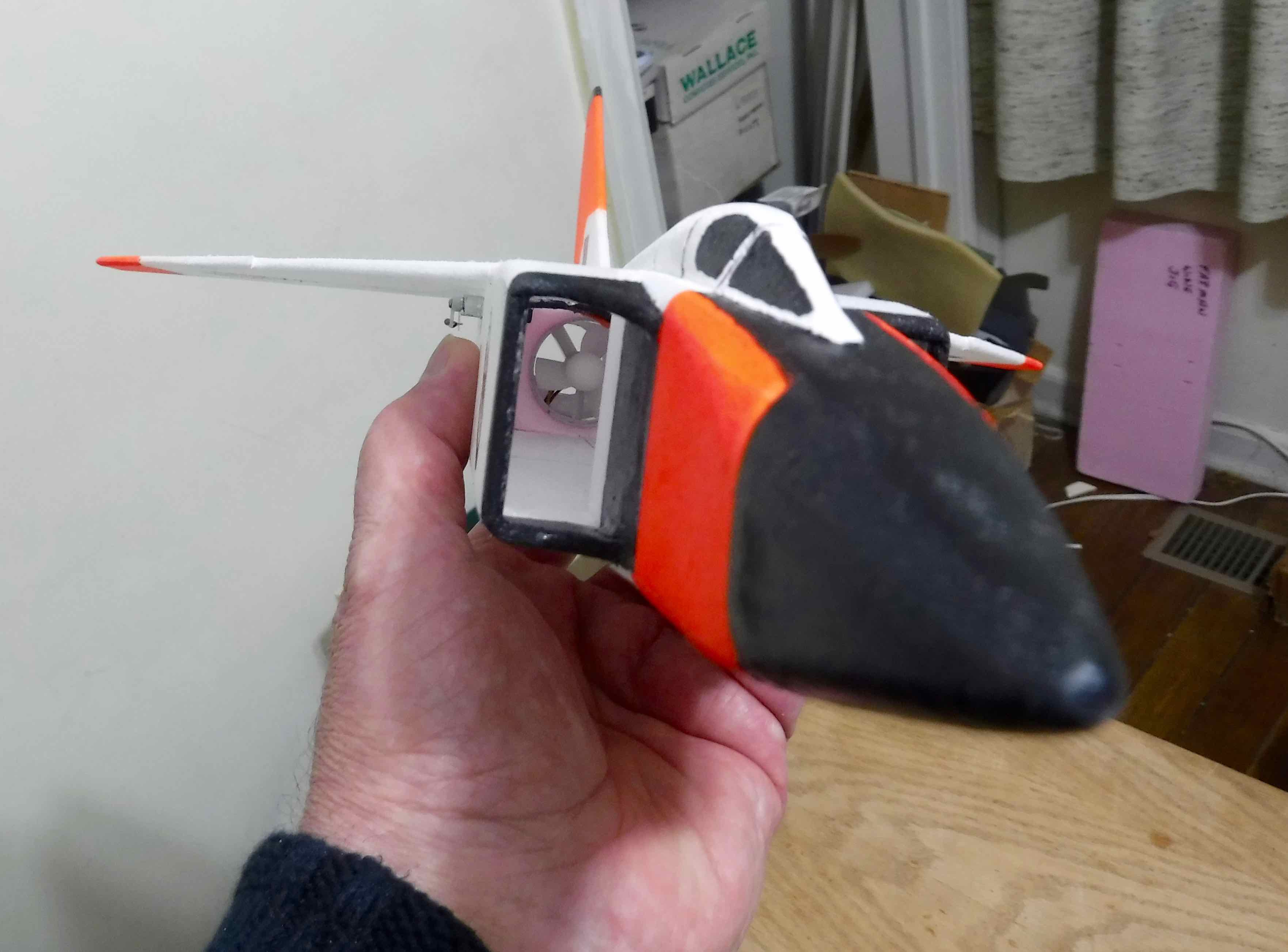 The Sabre had a 15" span, about 45 sq.in., and weight of 2.6 oz. I couldn't test the thrust on the Sabre due to the state of destruction. 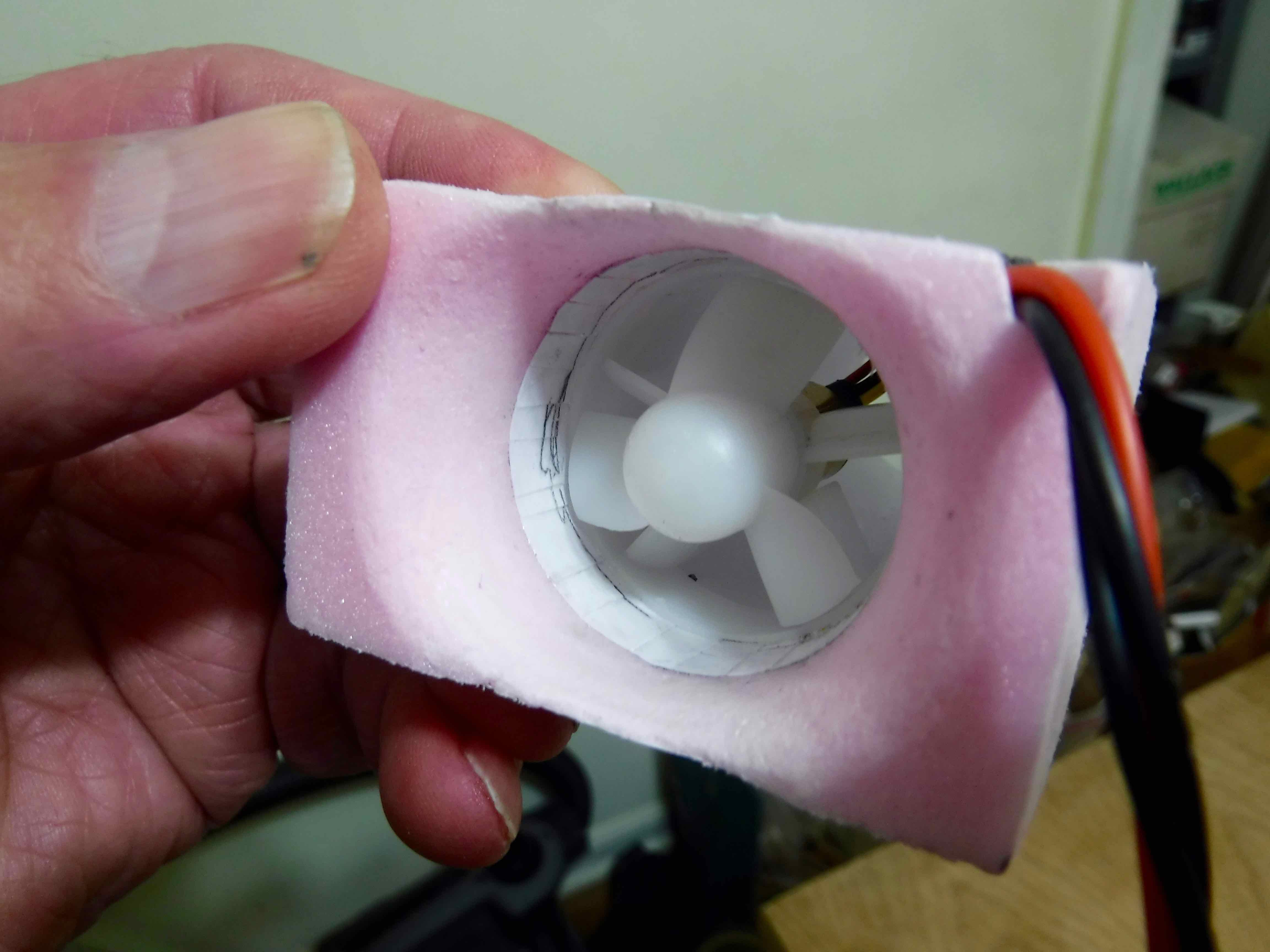 The Arrow is built mostly from 3mm Depron with a few bits of pink styrofoam for the nosecone, tailcone, and canopy. 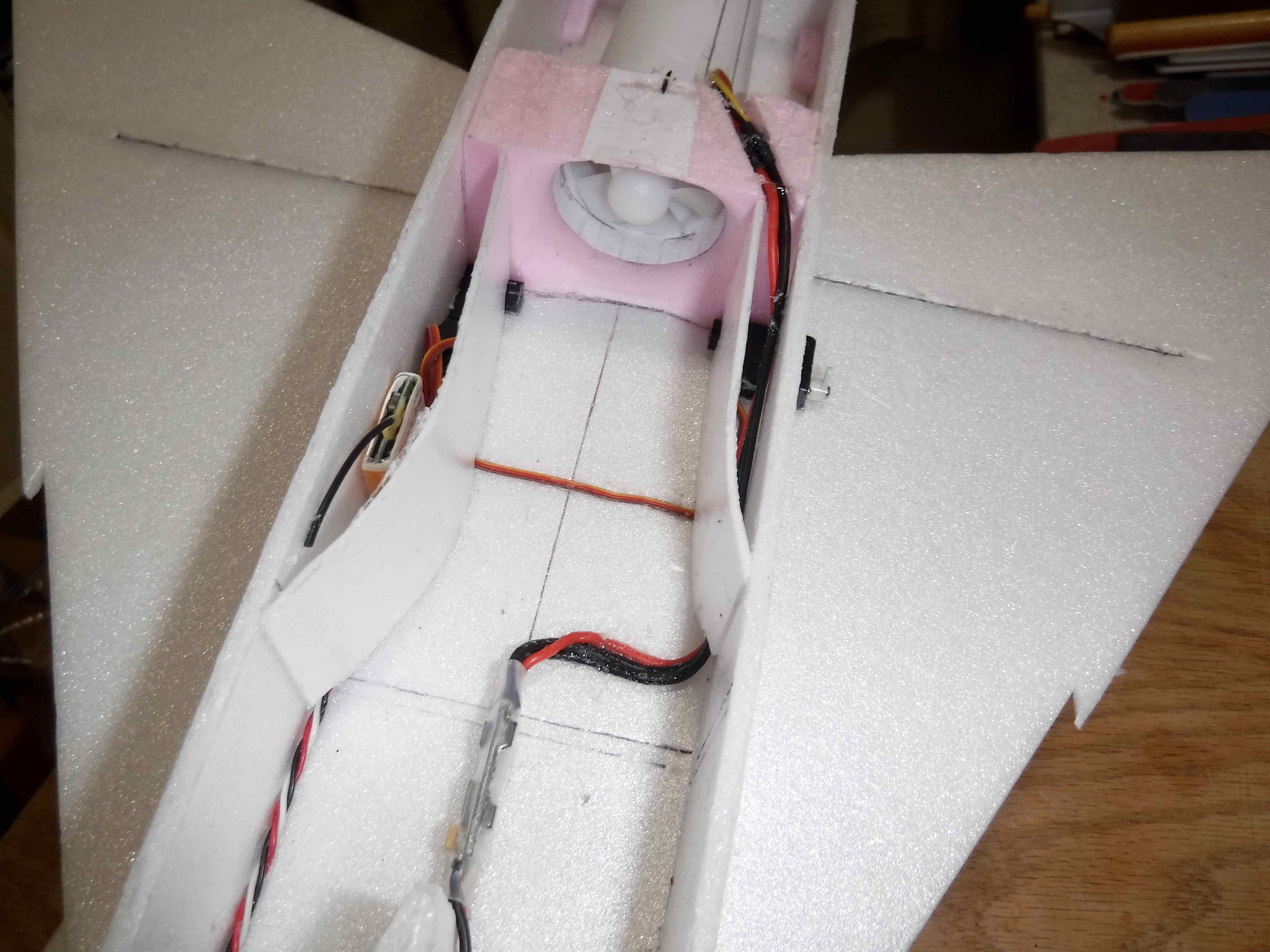
I made a bell mouth for the fan and arranged the equipment to get the best possible air passage. It has almost 90 sq.in yet. weighs only 2.1 oz. with the 2 cell 250 mAh LiPo. Static thrust is 1.9 oz. 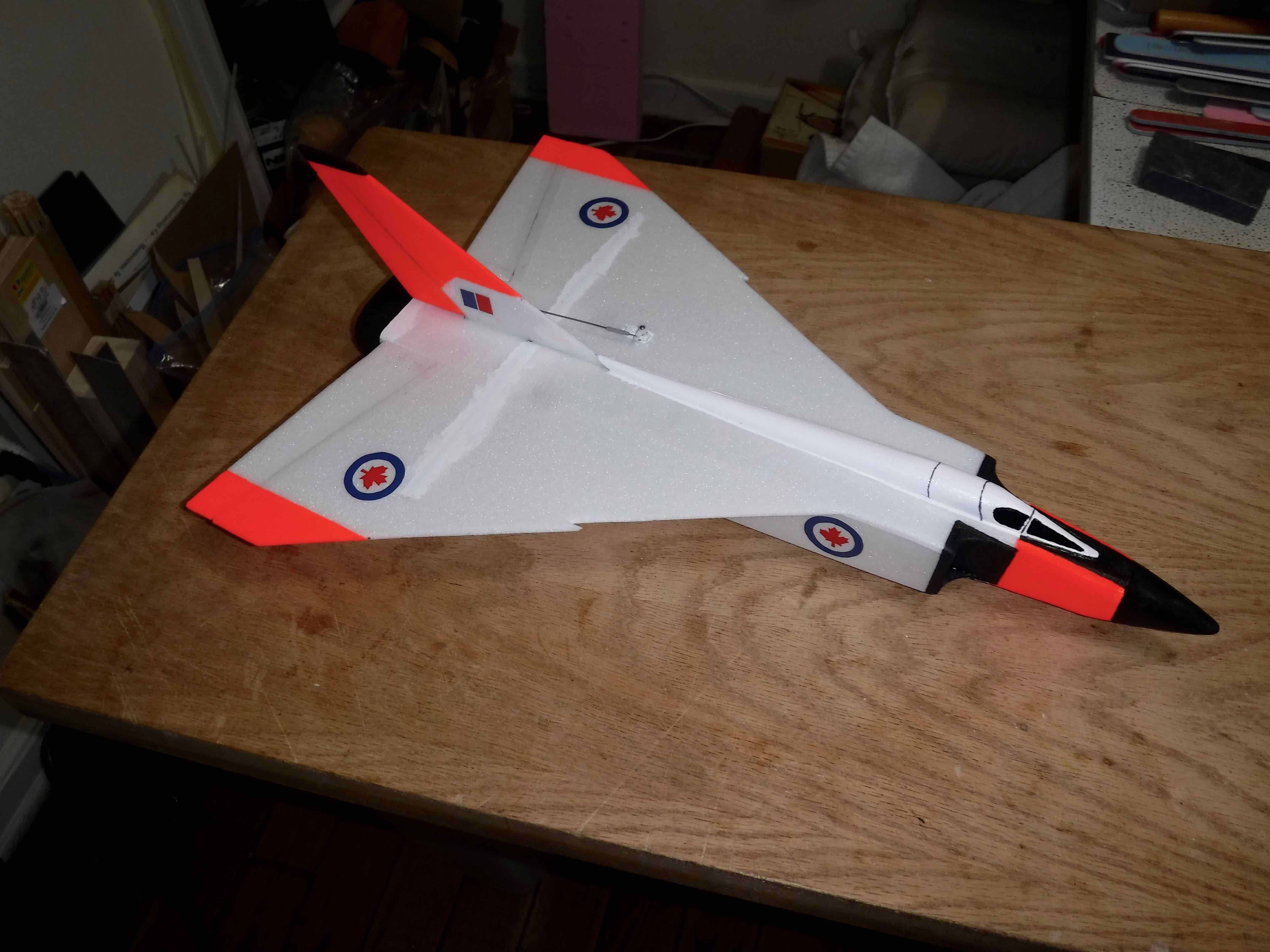 I kept it quite close to scale except for a few things. The nose is shortened by 1" (between the cockpit and leading edge) so that it could fit in the original box, the exhaust area was simplified, and the fuselage depth increased by 0.1". All other shapes and cross-sections are reasonably close to scale. 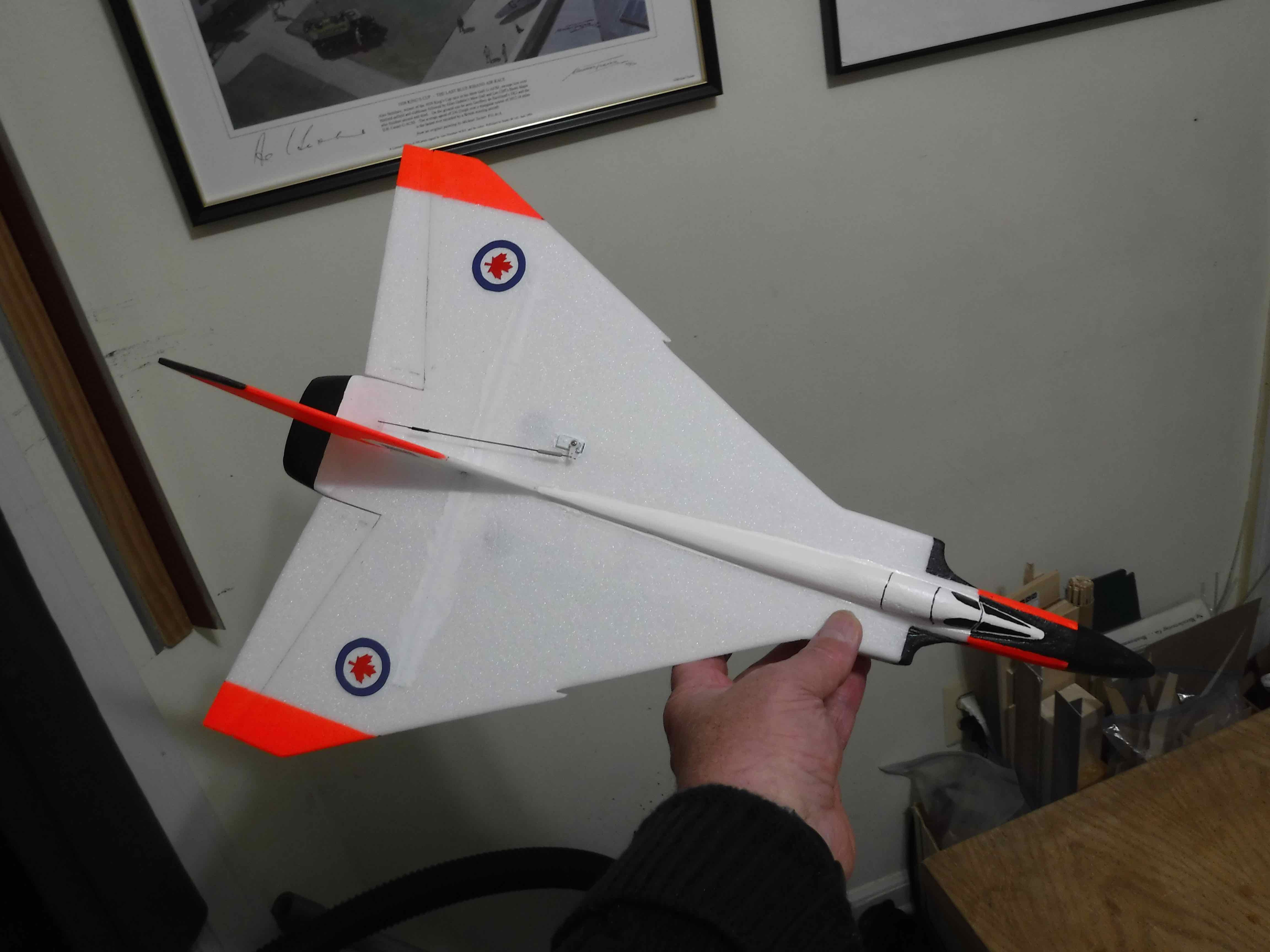
It is basically a three day plane: one to design and draw the plans; one to cut the parts out and assemble and install the equipment; and one day to paint details and cut out film for the Maple Leaf markings.  I am looking forward to a calm evening to do a test flight. These small quick projects can be very worthwhile and rewarding. I now feel like returning to the (secret) project with renewed vigor... Keith Old habits die hard. My parents hated to see anything go to waste. Even though we were quite poor, my mother would meticulously repair clothing and donate it to charity. My father would go down the street on trash night and bring back anything he thought he could fix, either for us or to give to a neighbor in need. It was absolutely forbidden to sell any item, just a thank you was enough. I was enlisted to repair anything electrical/electronic as that was beyond my Dad's ability. Later we would work on things together as his vision and health began to fade. I still carry on that tradition for my neighborhood and it has also become part of my modeling. I pick up trashed planes and either repair them to be used as club trainers, or strip them of parts for my own use. Rarely do I have to buy any hardware, such as kwik links, wheel, spinners, bolts/nuts, etc. It also gives me perverse pleasure to turn an ARF into a handmade plane. I've included a couple of photos of my Jeanin Taube that began life as a Flyzone Albatros. It is also made of 2mm and 3mm Depron. 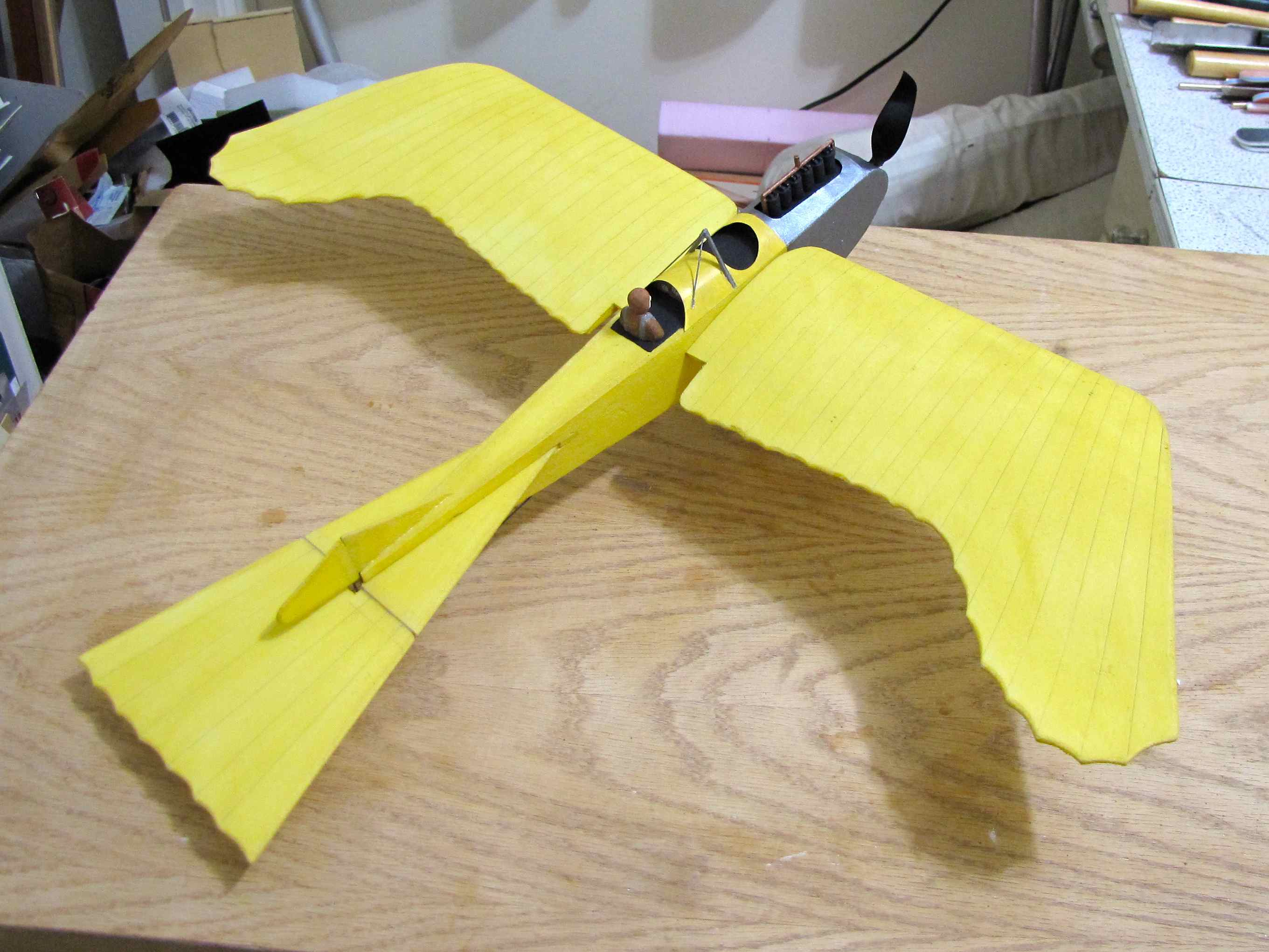
Keith A Different Way of Calculating Wing Area and Various Wing Loading Methods Compared
We are now in the buy and fly era of model aviation. A large number of people who enter the hobby today just purchase a bind-and-fly (BNF) or ready-to-fly (RTF) model airplane instead of creating their own model airplane. Once it assembled, they expect it to fly as described in the various reviews; hobby magazines, online (Web site) or video (i.e. YouTube). The only airframe parameters they are interested in is wingspan and fuselage length. In other words, "Will it fit in my vehicle?" or "How many can I fit in my vehicle?" With a few more airframe parameters, a person who's been in the hobby for awhile can compare and predict the flight characteristics of an unknown airframe. The added parameters provide useful information to those who have passed the introductory stage of RC modeling. Many magazine reviewers provide the ready to fly (RTF) weight. If the RTF weight is given as 5.1 oz. to 5.6 oz. and the wing span is noted as 28.15", it does provide a little comparative information when comparing it to to another model that has a RTF weight of 2.22 lb. (35.5 oz.) with a wingspan of 65", but not much. As a quick mental exercise, try to arrange the following in order from easiest to fly to hardest. All the planes were reviewed in the Winter 2018 issue of "PARKPILOT" magazine. Horizon Hobby E-Flite UMX Aero Commander 5.6 oz. & 28.15" - 2.39 oz./ft.
This method has an obvious flaw. The Waco is a biplane and only the wingspan of the top wing is noted. That is okay for noting how much space the top wing will require, but not so good for comparative information. Ounces per linear foot is an oddball way to try the anticipate possible flight characteristics and similarities of flight of various model planes. Full scale designers, and modelers, have used ounces, or sometimes pounds, per square foot of wing area for generations as a comparative and anticipatory value. A look at the example planes using ounces per square foot of the wing planform area. Horizon Hobby E-Flite UMX Aero Commander 5.6 oz. & 93.1 sq.in. - 8.66 oz./sq.ft.
Origin Funter Glider Trainer EP RR 35.5 oz. & 434 sq.in. - 6.55 oz./sq.ft.
Hacker Model Pilatus Turbo 890mm EP ARF 7.3 oz. & ?? sq.in - ?? oz./sq.ft.
Horizon Hobby Blade UMX F-27 FPV BNF Basic 2.8 oz. & ?? sq.in. - ?? oz./sq.ft.
Horizon Hobby HobbyZone T-28 Trojan S RTF with SAFE 1.65 oz. & ?? sq.in. - ?? oz./sq.ft.
Horizon Hobby E-flite X-VERT VTOL BNF Basic 7 oz. & 120 sq.in. - 8.4 oz./sq.ft.
Tough Jets T-15 40 oz. & 615 sq.in - 9.37 oz./sq.ft.
Horizon Hobby E-flite UMX Waco BL BNF Basic 3.5 oz. & 132 sq.in. - 3.82 oz./ft.
Arranging these planes by ounces per square foot, for comparison purposes is a bit easier, except three of the planes cannot be arranged by wing planform area loading because the wing planform area is not available. The F-27 and T-28 are somewhat similar, with some of the shortest wingspans in the group, and both are 'low weight' models, so they could be expected to fly in a similar fashion. The Hacker Model Pilatus Turbo 890mm EP ARF with a 35" wingspan and 7.3 oz. weight would fly differently.
There is a manual for the Hacker Pilatus. On p. 6 of the manual it shows the main parts with the wing panels included. There is also a known measurement available on page 1. The wingspan is noted as 890mm, which is (35.03937 inches). A screen grab can be made of the wing panels and saved. The saved file can be imported into a CAD program, traced and then enlarged based on the given wingspan to give the actual dimensions. That method yielded 434 sq.in. for this model. 7.3 oz. & 434 sq.in. - 2.42 oz./sq.ft. Using the same method with a bottom view photo from Horizon's Web site for the F-27 yielded about 83.5 sq.in. 2.8 oz. & 83.5 sq.in. - 4.83 oz./sq.ft. A top view from the manual for the T-28 Trojan was used in the same manner. The wing area was calculated as 51 sq.in. 1.65 oz. & 51 sq.in. - 4.66 oz./sq.ft. The method of using CAD is a very convoluted way to estimate the wing area, but it is better than nothing, which is what was provided by both the suppliers and reviewers for these planes. There are many ways that the estimated wing area could be off some, but it should be relatively close. Luckily, reviewers do have a quite an easy way to calculate the wing area because they have the model "in hand". Calculating the area or a rectangle or trapezoid is pretty straight forward. Sometimes though, you are curious about the wing tip area or the wing or wings have an 'odd' shape to them. The following method can be used to include wing tips or when dealing with oddly shaped wings. Items Required: a scale for weighing relatively light objects, a piece or two of Dollar Tree Foam Board or Ross Foam Board available at Walmart depending on the size of the wing, a single edge razor blade and/or X-ACTO knife with a #11 blade, a pen Procedure:
My example is for a fairly large wing. Two pieces of foam board are required, as the chord, at its widest point is 10-3/8" and foam board is only approximately 20" wide. Two different brands of foam board were used as a 'check' of the method against each other. The DTFB sheets weighed 0.184g per square in.
 When the two wing panels were cut out of DTFB, the two panels weighed 107.2 g.
I am comfortable in noting the wing area as 585 sq.in. Some people believe that the mathematical wing cube loading value is even more useful to make comparative judgements about the flyability of different planes. There is a lot of information on the EFO Web site about the wing cube loading value. The most recent is "Wing Cube Loading", By Ken Myers, February 2018. The formula for a WCL comparative value is:
The weight, in ounces, is then divided by the cubic value and that yields a comparative value, which is typically, not assigned a unit value.
Tough Jets example:
 The table compares all three methods for determining comparison factors and flyability of the eight airplanes reviewed in "PARKPILOT." In the table, the planes are listed from the lowest value in each column to the highest. That sorts them by their ease of flyability. The wing planform area loading arrangement is somewhat similar to the WCL value arrangement, but not quite. The Tough Jets T-15 is the most notable example of a change in position when the WCL value is used. The T-15 is also the 'largest' of the review models. It is often said that larger models 'fly better'. There are many reasons for that, but the WCL value offers a quantified value for that statement. The common wing planform area loading does not take that into account. The table also shows some subjective comments about the flyability of the reviewed airplanes for comparison to the WCL values. How hard can it be to fly the T-15 when the reviewer notes that it can land at walking-speed when no wind is present, yet wing planform area loading indicates that it should be "the hardest to fly"? To provide the useful wing planform area, reviewers could use the weight to area method of calculating the approximate wing planform area. For those interested, it could be a helpful indicator. 35th Annual Mid-America Electric Flies 2019
The 7 Mile Rd. Flying Site, Salem Twp., MI
Contest Directors are:
Flying both days at the Midwest R/C Society Flying Field - 7 Mile Rd., Salem Twp., MI Registration: 9 A.M. both days
Pilot Entry Fee: 18 and over, $15 Sat. - $10, Sunday, (ask about the family rate),
Saturday's Awards
Sunday's Awards
Planes Must Fly To Be Considered for Any Award
Open Flying Possible on Friday
Potluck picnic at the field on Saturday evening. Come and join us for two days of fun and relaxed electric flying. Come, Look, Listen, Learn - Fly Electric - Fly the Future!
Special Events Again this year for NCM (Not Conventional Materials) aircraft
Foam Flurry for NCM aircraft:
Most Unique NCM Aircraft Award:
To locate the Midwest R/C Society 7 Mile Rd. flying field, site of the Mid-America Electric Flies, look near top left corner of the map, where the star marks the spot, near Seven Mile Road and Currie Rd. Link to the map. The field entrance is on the north side of Seven Mile Road about 1.6 Miles west of Currie Rd.
Because of their convenient location and the easy drive to the flying field, the Comfort Suites and Holiday Inn Express in Wixom, MI have been added to the hotels' listing. They are only 10 miles northwest of the field and located near I-96 and Wixom Road. See the map-hotel .pdf for more details.
To Reach Ken Myers, you can land mail to the address at the top of the page. My E-mail address is: KMyersEFO@theampeer.org |
